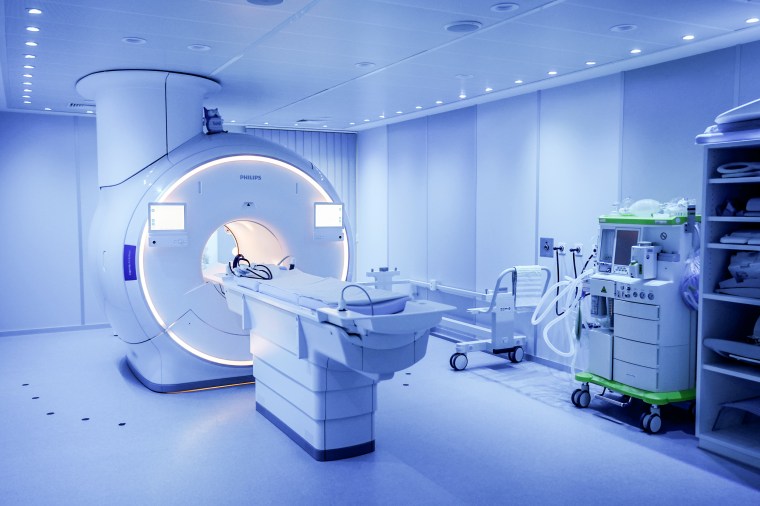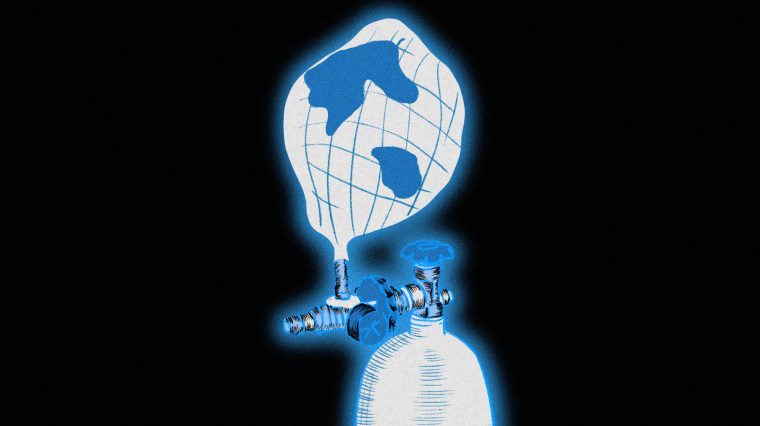A global helium shortage has doctors worried about one of the natural gas’s most essential, and perhaps unexpected, uses: MRIs.
Strange as it sounds, the lighter-than-air element that gives balloons their buoyancy also powers the vital medical diagnostic machines. An MRI can’t function without some 2,000 liters of ultra-cold liquid helium keeping its magnets cool enough to work. But helium — a nonrenewable element found deep within the Earth’s crust — is running low, leaving hospitals wondering how to plan for a future with a much scarcer supply.
“Helium has become a big concern,” said Mahadevappa Mahesh, professor of radiology at the Johns Hopkins School of Medicine Baltimore. “Especially now with the geopolitical situation.”
Helium has been a volatile commodity for years. This is especially true in the U.S., where a Texas-based federal helium reserve is dwindling as the government tries transferring ownership to private markets.
Until this year, the U.S. was counting on Russia to ease the tight supply. An enormous new facility in eastern Russia was supposed to supply nearly one-third of the world’s helium, but a fire last January derailed the timeline. Although the facility could resume operations any day, the war in Ukraine has, for the most part, stopped trade between the two countries.
Now, four of five major U.S. helium suppliers are rationing the element, said Phil Kornbluth, president of Kornbluth Helium Consulting. These suppliers are prioritizing the health care industry by reducing helium allotments to less essential customers.
“Helium is on allocation for sure,” said Donna Craft, a regional construction manager for Premier Inc. who contracts with helium suppliers for some 4,000 hospitals. “We’re probably not blowing up balloons in the gift shop anymore.”
Hospitals haven’t canceled patients’ MRIs or shut down machines yet. They have seen helium costs rise at an alarming rate, though — possibly up to 30%, Kornbluth guessed. But without an end in sight for the helium shortage, the future of MRI remains uncertain.
‘An essential commodity’
MRI, short for magnetic resonance imaging, has been a staple of health care since the 1980s. The massive machines provide high-resolution images that allow doctors to see details in organs, bones and tissue that may not show up on X-rays.
“You get these sharp images, and you can distinguish soft tissues,” said Dr. Scott Reeder, chief of MRI at the University of Wisconsin School of Medicine and Public Health. “It’s central to many things we do in modern medicine.” MRIs help doctors diagnose brain tumors, strokes, spinal cord injuries, liver diseases and cancer. The 3D images, experts say, are irreplaceable.
Instead of relying on X-rays, which emit trace amounts of radiation to peer inside the body, MRIs use magnetic fields and radio waves. When someone lies stock-still inside the tube-shaped magnetic field, their body’s atoms align with strong magnetic currents. Pulses of radio waves then tell the machine’s sensors which tissues are where, and the machine renders its image.

Keeping an MRI’s magnetic current superconductive requires extreme cold. That’s where helium comes in: With a boiling point of minus 452 degrees Fahrenheit, liquid helium is the coldest element on Earth. Pumped inside an MRI magnet, helium lets the current travel resistance-free.
“Helium is how the magnet continuously exists,” Mahesh said. “It’s an essential commodity.”
At any point, an MRI machine contains about 2,000 liters of liquid helium, though suppliers need to replenish any helium that boils off. Mahesh estimates that an MRI machine uses 10,000 liters of liquid helium over its life span. (According to GE Healthcare, a manufacturer of the machines, that life span is 12.8 years.) In 2015, there were roughly 12,000 machines in the U.S., making MRIs one of the biggest helium consumers in the world, far above balloon stores.
In contrast, spectators have an estimated 400,000 cubic feet of helium to thank for suspending all of the tractor-trailer-size balloons in Macy’s Thanksgiving Day Parade. Converted to liquid form, that helium would only keep about two MRIs operational for their life span.
No quick fix
The problem is that no other element is cold enough for the MRI. “There’s no alternative,” Craft, of Premier Inc., said. “Without helium, MRIs would have to shut down.”
Manufacturers like GE Healthcare and Siemens Healthineers recognize this vulnerability. “We are concerned about shortages in the helium market,” said Ioannis Panagiotelis, chief marketing officer of MRI at GE. “Every industry and hospital with an MR system has been affected.”
GE and Siemens are both developing MRIs requiring less liquid helium. Siemens recently introduced one requiring just 0.7 liters, and, according to Panagiotelis, GE rolled out a machine that’s “1.4 times more efficient than previous models.” These technologies aren’t widely available, though, and replacing the country’s 12,000 MRI machines — each weighing up to 50,000 pounds — is anything but a quick fix. Meanwhile, hospitals keep installing additional conventional MRI machines to meet demand for diagnostic scans.
“The concern is the shortage becomes so acute we can’t set up new scanners,” Reeder said. The University of Wisconsin, he said, has plans to open a new cancer center with two MRIs. “When we install those systems, what’s going to happen if there’s no helium?”
Mahesh said Johns Hopkins is also adding another MRI to its fleet, and it’ll be the same “workhorse scanner” as its 22 other machines.
As doctors dread possible worst-case scenarios, scientists who use liquid helium for research are already there. When suppliers began rationing this summer, Harvard University physicists Amir Yacoby and Philip Kim shut down around half of their labs’ projects. On the opposite side of the country, the University of California, Davis reported that one of its helium suppliers cut allocations by half, including for medical use.
“The shortage is motivating us to figure out ways of doing the same experiments without the liquid helium,” Yacoby said. The forced innovation may preview what’s to come for MRIs, and it may be necessary, shortage or no shortage.
“There’s only a finite amount of helium in the Earth’s crust,” Kim said. “Once it evaporates off, it’s completely lost into outer space.”
CORRECTION (October 26, 10:56 a.m. ET): A previous version of this article misstated the company Donna Craft works for. It is Premier Inc., not Premier Health.
Follow NBC HEALTH on Twitter & Facebook.
